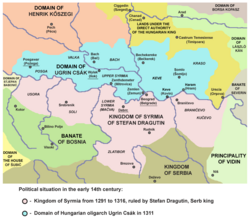Realm of Stefan Dragutin
This article includes a list of references, related reading, or external links, but its sources remain unclear because it lacks inline citations. (February 2013) |
Kingdom of Syrmia Сремска краљевина Sremska kraljevina | |
|---|---|
| 1282–1325 | |
 Kingdom of Syrmia of Stefan Dragutin (1291-1316) | |
| Status | vassal kingdom of the Kingdom of Hungary[1] |
| Capital | Debrc and Belgrade |
| Government | kingdom |
| Historical era | Middle Ages |
• Established | 1282 |
• Disestablished | 1325 |
| Today part of | Serbia, Bosnia and Herzegovina |

The Kingdom of Syrmia ([Sremska kraljevina / Сремска краљевина] Error: {{Lang-xx}}: text has italic markup (help)) was a vassal kingdom of the Kingdom of Hungary[1] ruled by the Serb kings Stefan Dragutin (1282–1316) and his son Stefan Vladislav II (1316–1325). Situated in the region of Lower Syrmia, the first capital of the kingdom was Debrc (in Mačva), while residence of the king was later moved to Belgrade.
Territory
In the Middle Ages, Syrmia was a larger area around the confluence of the rivers Sava and Danube. The part between the two rivers, being upstream, was known as Upper Syrmia, while the area south of the rivers was known as Lower Syrmia. The kingdom was centered in the Banate of Mačva, but also included Belgrade, Rudnik, parts of Župa of Podrinje and the Banates of Braničevo, Kučevo, Usora and Soli. According to Serbian historian Stanoje Stanojević, the kingdom also included Upper Syrmia.
History
Stefan Dragutin was initially a king of Serbia from 1276 to 1282. In 1282 he broke his leg while hunting and became ill; he passed the throne to his younger brother Stefan Milutin at the council at Deževo in 1282, while keeping for himself some northern parts of the country (Rudnik and parts of Župa of Podrinje). Since his son Vladislav married the relative of the Hungarian king, Dragutin in 1284 gained from Ladislaus IV the Banates of Mačva (including Belgrade), Soli and Usora, which he ruled as a vassal of the King of Hungary. Dragutin's new state was named Kingdom of Syrmia. The first capital of his state was Debrc (between Belgrade and Šabac), and later he moved his residence to Belgrade. Dragutin was the first Serb ruler who ruled from Belgrade as the capital.
In roughly 1291 and with the help of Milutin, Stefan Dragutin expanded his territory by annexing Braničevo and Kučevo, whose Bulgarian nobles Darman and Kudelin recently became independent from the Kingdom of Hungary.[2] For the first time, that province was in the hands of a Serb.[1] This action probably caused the war between the Bulgarian despot Shishman of Vidin and Milutin of Serbia.
Near the end of his life he separated from his Hungarian friends and strengthened his connections in Serbia. He later became a monk and changed his name to Teoktist. He died in 1316 and was buried in the Đurđevi Stupovi monastery near Novi Pazar.
After king Dragutin died, his son Stefan Vladislav II assumed the Syrmian throne. However in 1319, Milutin, Vladislav's uncle and the king of Serbia, invaded, defeating and imprisoning Vladislav. When Milutin died in 1321, the newly freed Vladislav recovered his father's lands, with the help of the Hungarians and Stephen II, Ban of Bosnia. (Vladislav's mother was the daughter of former Hungarian King Stephen V. Vladislav's wife was the aunt of former Hungarian King Andrew III. Ban Stephen II was the son of Vladislav's sister.)
After having been beaten again by supporters of Stefan Dečanski (successor of Milutin), Vladislav II retreated to the Kingdom of Hungary in 1324. Vladislav II's nephew, Ban Stephen II, reincorporated Soli and Usora into Bosnia. Belgrade and the northern part of Mačva along the river Sava remained a part of Hungary, while the southern part and Braničevo remained Serbian. The Kingdoms of Serbia and Hungary would contest Lower Syrmia for the next century.
Rulers
- Stefan Dragutin (1282-1316)
- Stefan Vladislav II (1316-1325)
See also
External links
- Map of Dragutin's Kingdom of Syrmia
- Map of Dragutin's Kingdom of Syrmia
- Map of Dragutin's Kingdom of Syrmia
- Map of Dragutin's Kingdom of Syrmia
- Map of Dragutin's Kingdom of Syrmia (from book "Hrvatska povijest u 25 karata", written by Stjepan Srkulj and Josip Lučić)
References
- ^ a b c Fine, John V.A. (1987). The late medieval Balkans: a critical survey from the late twelfth century to the Ottoman Conquest. Ann Arbor: University of Michigan Press. p. 220. ISBN 978-0-472-10079-8. OCLC 13860868.
- ^ Vásáry, István (2005). Cumans and Tatars: Oriental Military in the Pre-Ottoman Balkans, 1185-1365. Cambridge University Press. p. 104. ISBN 9780521837569.
Sources
- Miomir Filipović - Fića, Tri cara i trideset i jedan kralj srpskog naroda, Čikago, 1992.
- Drago Njegovan, Prisajedinjenje Vojvodine Srbiji, Novi Sad, 2004.
- Small encyclopedia "Sveznanje" published by "Narodno delo", Belgrade, in 1937 which is today in public domain.


